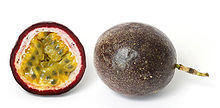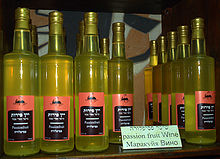- Passiflora edulis
-
"Passionfruit" and "Passion fruit" redirect here. For other uses, see Passion fruit (disambiguation)
Passionfruit, Maracujá 
Ripe purple type from Australia and its cross section Scientific classification Kingdom: Plantae (unranked): Angiosperms (unranked): Eudicots (unranked): Rosids Order: Malpighiales Family: Passifloraceae Genus: Passiflora Species: P. edulis Binomial name Passiflora edulis
Sims, 1818Passiflora edulis is a vine species of passion flower that is native to Paraguay, Brazil and northern Argentina (Corrientes and Misiones provinces, among others). Its common names include passion fruit (UK and US) and passionfruit (Australia and New Zealand). It is cultivated commercially in warmer, frost-free areas for its fruit and is widely grown in India, Sri Lanka, New Zealand, the Caribbean, Brazil, Colombia, Bolivia, Ecuador, Indonesia, Peru, California, Florida, Haiti, Hawaii, Argentina, Australia, East Africa, Mexico, Israel, Costa Rica, South Africa and Portugal (Azores and Madeira). The passion fruit is round to oval, either yellow or dark purple at maturity, with a soft to firm, juicy interior filled with numerous seeds.[1] The fruit is both eaten and juiced; passion fruit juice is often added to other fruit juices to enhance the aroma.[2]
The two types of passion fruit have clearly differing exterior appearances. The bright yellow variety of passion fruit, which is also known as the Golden Passion Fruit, can grow up to the size of a grapefruit, has a smooth, glossy, light and airy rind, and has been used as a rootstock for the Purple Passion Fruit in Australia.[3] The dark purple passion fruit is smaller than a lemon, though it is less acidic than the yellow passion fruit, and has a richer aroma and flavor.[4]
In Colombia, the purple passion fruit is referred to as "gulupa", to distinguish it from the yellow maracuyá.
The purple varieties of the fruit have been found to contain traces of cyanogenic glycosides in the skin.[5]
Contents
Uses
- In Brazil, passion fruit mousse is a common dessert, and passion fruit seeds are routinely used to decorate the tops of cakes. Passion fruit juice is also very common. When making Caipirinha, it is common to use passion fruit instead of lime. It is also used as a mild sedative, and its active ingredient is commercialized under several brands, most notably Maracugina.
- In Colombia this is one of the most important fruits, especially for juices and desserts. It is a common fruit all over the country and there you can find 3 kinds of "Maracuyá" fruit.
- In the Dominican Republic, where it is locally called chinola, it is used to make juice and jams. Passion fruit-flavoured syrup is used on shaved ice, and the fruit is also eaten raw sprinkled with sugar.
- In Hawaii, the varieties are called yellow lilikoi and purple lilikoi and the fruit is normally eaten raw. Hawaiians usually crack the rind of the passion fruit either with their hands or teeth and suck out the flavorful pulp and seeds.[citation needed] Passion fruit can also be cut in half and the pulp can easily be scooped out with a spoon. Passion fruit-flavored syrup is a popular topping for shave ice. Ice cream and mochi are also flavored with passion fruit, as well as many other desserts such as cookies, cakes, and ice cream. Passion fruit is also favored as a jam or jelly, as well as a butter. Passion fruit is not widely available in stores, so most of the fruit comes from backyard gardens or wild groves. It can be found, however, in farmers' markets throughout the islands.
- In Indonesia, there are two types of passionfruit (local name: 'markisa'), white flesh and yellow flesh. The white one is normally eaten straight as a fruit. The yellow one is commonly strained to obtain its juice, which is cooked with sugar to make thick syrup. Bottles or plastic jugs of concentrated syrup (generally produced in Sumatra from fruit grown in the Lake Toba region[citation needed]) are sold in many supermarkets. Dilution of one part syrup to four (or more) parts water is recommended.
- In New Zealand and Australia, where it is called "passionfruit", it is available commercially both fresh and tinned. Fresh passionfruit is eaten for breakfast in the Summer months, is added to fruit salads, and fresh fruit pulp or passion fruit sauce is commonly used in desserts, including as a topping for pavlova (a regional meringue cake) and ice cream, a flavouring for cheesecake, and in the icing of vanilla slices. A passionfruit-flavoured soft drink called Passiona has also been manufactured in Australia for several decades.
- In Paraguay, passion fruit is used mainly to make juice, prepare desserts like passion fruit mousse,cheesecake, ice cream, to flavor yogurts and cocktails.
- In Mexico, passion fruit is used to make juice or is eaten raw with chili powder and lime.
- In Puerto Rico, where the fruit is known as "Parcha", it is widely believed to lower blood pressure,[6] probably because it contains harmala alkaloids and is a mild RIMA.[citation needed] Passion fruit juice is also very common there and is used in juices, ice cream or pastries.
- In Peru, passion fruit is used in several desserts, especially cheesecakes. It is also drunk alone as passion fruit juice and used in ceviche variations and in cocktails, including the passion fruit sour, a variation of the Pisco Sour.
- In the Philippines, passion fruit is commonly sold in public markets and in public schools. Some vendors sell the fruit with a straw in it to suck the seeds and juices inside. It is not very popular because of its sour flavor, and the fruit is very seasonal.
- In South Africa, passion fruit, known locally as Granadilla (the yellow variety as Guavadilla), is used to flavor yogurt. It is also used to flavour soft drinks such as Schweppes Sparkling Granadilla and numerous cordial drinks. It is often eaten raw or used as a topping for cakes and tarts. Granadilla juice is commonly available in restaurants. The yellow variety is used for juice processing, while the purple variety is sold in fresh fruit markets.
- In Sri Lanka passion fruit juice, along with faluda is one of the most popular refreshments. Passion fruit cordial is manufactured both at home as well as industrially by mixing the pulp with sugar, there being a large quantity of cordial manufacturers, suppliers and exporters in the country.[7]
- In the United States, it is often used as an ingredient in juice mixes.
- In Vietnam, passion fruit is blended with honey and ice to create refreshing smoothies.
Nutrition
Passion-fruit, (maracuya), purple, raw Nutritional value per 100 g (3.5 oz) Energy 406 kJ (97 kcal) Carbohydrates 23.38 g - Sugars 11.20 g - Dietary fiber 10.4 g Fat 0.70 g Protein 2.20 g Vitamin A equiv. 64 μg (8%) Riboflavin (vit. B2) 0.130 mg (11%) Niacin (vit. B3) 1.500 mg (10%) Folate (vit. B9) 14 μg (4%) Vitamin C 30.0 mg (36%) Calcium 12 mg (1%) Iron 1.60 mg (12%) Magnesium 29 mg (8%) Phosphorus 68 mg (10%) Potassium 348 mg (7%) Zinc 0.10 mg (1%) Nutrient values and weights are for edible portion.
Percentages are relative to US recommendations for adults.
Source: USDA Nutrient DatabaseFresh passion fruit is high in beta carotene, potassium, and dietary fiber. Passion fruit juice is a good source of ascorbic acid (vitamin C), and good for people who have high blood pressure.[8] Some research is showing that purple passion fruit peel may help with controlling asthma symptoms.[9] The yellow variety is used for juice processing, while the purple variety is sold in fresh fruit markets. The fruit contains Lycopene in the mature and immature pericarp.[10]
Culture
The Passion fruit is so called because it is one of the many species of Passion Flower. ("Passion Flower" being the literal English translation of the Latin genus name, Passiflora). The name was given by missionaries because the parts of the flower seemed reminiscent of the torture (the Passion) of Christ prior to his crucifixion:
- The three stigmas reflect the three nails in Jesus's hands and feet.
- The threads of the passion flower resemble the Crown of Thorns.
- The vine's tendrils are likened to the whips.
- The five anthers represented the five wounds.
- The ten petals and sepals regarded to resemble the Apostles (excluding Judas and Peter).
- The purple petals representing the purple robe used to mock Jesus' claim to kingship (Mt. 27:28)
The flower of the passion fruit is the national flower of Paraguay.
See also
Gallery
References
- ^ "Passion Fruit: Background, Nutrition, Preparation". Exotic Fruit for Health. 25 August 2011. http://www.exoticfruitx.com/2011/08/passion-fruit-background-nutrition-preparation/. Retrieved 18 September 2011.
- ^ "Passiflora edulis Sims". Germplasm Resources Information Network. United States Department of Agriculture. 2007-06-25. http://www.ars-grin.gov/cgi-bin/npgs/html/taxon.pl?26962. Retrieved 2010-01-07.
- ^ Reynhardt, Debbie (8 February 2003). "Gardening with Debbie Reynhardt". Dispatch Online (Dispatch Media (Pty) Ltd). http://www.dispatch.co.za/2003/02/08/features/GARDEN.HTM. Retrieved 2006-11-20.
- ^ "Passion Fruit". California Rare Fruit Growers, Inc.. http://www.crfg.org/pubs/ff/passionfruit.html. Retrieved 22 October 2011.
- ^ Chassagne, David; Crouzet, Jean C.; Bayonove, Claude L.; Baumes, Raymond L. (18 December 1996). "Identification and Quantification of Passion Fruit Cyanogenic Glycosides". Journal of Agricultural and Food Chemistry (American Chemical Society) 44 (12): 3817. doi:10.1021/jf960381t.
- ^ "Make Choosing Good Food for High Blood Pressure an Easy and Exciting Experience". highbloodpressureinfo.org (Site Build It!). http://www.highbloodpressureinfo.org/food-for-high-blood-pressure.html. Retrieved 2010-08-13.
- ^ Passion fruit cordial Faluda and Sri Lankan food - TasteSpotting
- ^ "Passionfruit". organicfood.com (WSPA). http://www.organicfood.com.au/Content_Common/pg-passinfruit-information.seo. Retrieved 2008-08-25.
- ^ http://www.nhs.uk/news/2008/05May/Pages/Passionfruitpeelreliefforasthmatics.aspx
- ^ Evangelia Mourvaki, Stefania Gizzi, Ruggero Rossi, Stefano Rufini,"Passionflower Fruit—A "New" Source of Lycopene?", Journal of Medicinal Food. Spring 2005: 104-106.
External links
- Purdue.edu, Fruits of Warm Climates: Passionfruit
- CRFG.org, California Rare Fruit Growers: Passion Fruit Fruit Facts
- Passiflora.org, Passiflora Society International
- DaleysFruit.com.au, Australian Passionfruit Varieties
- Phytochemicals.info, phytochemicals in Passion Fruit
- Passionflow.co.uk, Passiflora Online
Categories:- Passiflora
- Plants described in 1818
- Tropical fruit
- Invasive plant species
- Flora of Argentina
- Flora naturalised in Australia
- Fruit
- Crops originating from Argentina
- Crops originating from Brazil
- Crops originating from Paraguay
Wikimedia Foundation. 2010.










